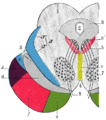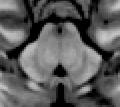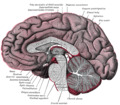| Cerebral aqueduct | |
|---|---|
 Section through superior colliculus showing path of oculomotor nerve. | |
 Drawing of a cast of the ventricular cavities, viewed from the side. | |
| Details | |
| Identifiers | |
| Latin | aqueductus mesencephali (cerebri). aqueductus Sylvii |
| MeSH | D002535 |
| NeuroNames | 509 |
| NeuroLex ID | birnlex_1261 |
| TA98 | A14.1.06.501 |
| TA2 | 5910 |
| FMA | 78467 |
| Anatomical terms of neuroanatomy | |
The cerebral aqueduct (aqueductus mesencephali, mesencephalic duct, sylvian aqueduct or aqueduct of Sylvius) is within the midbrain. It contains cerebrospinal fluid (CSF) and connects the third ventricle to the fourth ventricle, located dorsal to the pons and ventral to the cerebellum. The cerebral aqueduct is surrounded by an enclosing area of gray matter called the periaqueductal gray, or central gray.
It was first named after Franciscus Sylvius.
Structure
Development
The cerebral aqueduct, as other parts of the ventricular system of the brain, develops from the central canal of the neural tube, and it originates from the portion of the neural tube that is present in the developing mesencephalon, hence the name "mesencephalic duct."[1]
Function
The cerebral aqueduct acts like a canal that passes through the midbrain and connects the third ventricle with the fourth ventricle of the brain and the cerebrospinal fluid (CSF) finds its natural pathway through the cerebral ventricles and the canal connecting these ventricles.
Clinical significance
Aqueductal stenosis, a narrowing of the cerebral aqueduct, obstructs the flow of CSF and has been associated with non-communicating hydrocephalus. Such narrowing can be congenital, arise via tumor compression (e.g. pinealoblastoma), or through cyclical gliosis secondary to an initial partial obstruction.
Additional images
See also
References
- ^ Le, Tao; Bhushan, Vikas; Vasan, Neil (2010). First Aid for the USMLE Step 1: 2010 20th Anniversary Edition. USA: The McGraw-Hill Companies, Inc. pp. 126. ISBN 978-0-07-163340-6.
External links
- Atlas image: n2a3p2 at the University of Michigan Health System





